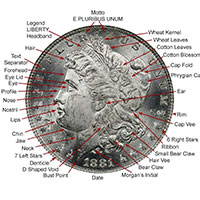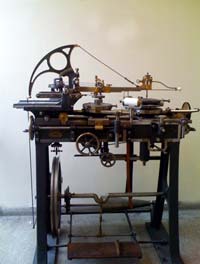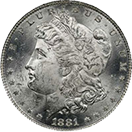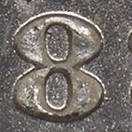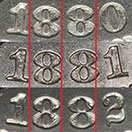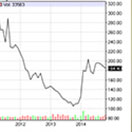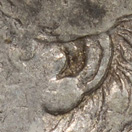Sources
Search
Contact
Home
For the most part all of the U. S. Mints were organized in the same way. This probably had some logic because the jobs were similar. But it also speaks to government logic and wanting to have things looks the same everywhere. This may or may not have been an efficient way to do business. The Treasurer's Report lists all of the jobs listed below and they would have existed at all the Branch Mints. Philadelphia would have had an expanded list of jobs, such as engravers.
Our thanks to Roger Burdette for his help in verifying our information and for filling in a lot of holes where we could not find data.
Adjusters at the Mint had the responsibility of weighing blanks before being upset and "adjusting" or reducing the weight of those weighing more than the prescribed tolerance. They also removed underweight blanks at this production step. Adjusters also weighed every gold coin following striking, and separated coins into categories by weight so that the total weight of each bag of gold coins would meet specified total weight tolerance.
After about 1852, this job seems to have been reserved for women and although difficult it was less labor intensive than others. Based on our research it was also a job requiring less education and often filled by either single women or widows. This was also one of the lower paid jobs because of needed skill level. But this was the most populous jobs because of the volume of blanks that needed to be touched prior to coining. (Mrs. E. A. Beals, Louisa Clark, Virginia Cretien, Annie E. Geale, Ella M. Gillen, Carrie E. Glenn, Harriet S. Hardee, Addie C. Hebert, Aimee Hill, Emma Kays, Lska B. Knox, Suzanne Kundert, Maggie Littrell, Mary Lynch, Annie P. Myers, Clara Oliver, Mrs. E. T. Proctor, Mrs. Mary D. Proctor, Sallie S. Sims, Amelia Stanard, Ionia Torrey, and Adele Urban)
The Adjuster of Scales and Weights worked in the Coiner's Department and had a very responsible job to keep the scales accurate. This mechanic maintained all the balances in the Mint and verified that they were performing correctly. Verification of the receipt of raw materials, correct weight of planchets, and weights of finished coins were essential to the proper manufacturing of coins. Without accurate scales this was impossible and we would assume the scales were test no less frequently than daily. (Jules Gouzy)
The Assayer position at each Mint was one with great responsibility and one that required experience and education. The Assayer had to certify the purity and alloy content of bullion, bars, ingots, planchets, and manufactured coins. This was also a position of significant power because the Assayer could accept or reject product at any stage of creation based on bad content. In our research we often found these men to have been doctors or pharmacists before their mint work. In the 1800s the qualifications for pharmacists and doctors were quite different and there was a lot of overlap with skills and experience. The Assayer also had to keep abreast of developments in the science of assaying and bring those to the Mint when appropriate. (Joseph Albrecht)
The Assayer's Clerk was obviously responsible for keeping records of transactions that took place within the Assayer's Department and between that department and others at the Mint. If there was a matrix management situation in the Mint this would have been one of those positions because all clerks in the Mint had to submit information and reports to the Chief Clerk for comprehensive analysis. (Samuel C. Stewart)
The Aging 1D
Submissions
Clashed Denticle
Date Issues
Encyclopedia
New Orleans and the Mint in 1881
The Devolving 5
One and Done
Two and Through
Fakes
Die Fingerprints
Pricing
The Devolving 27
New Orleans and The Mint in 1881
The Civil War
Politics
The Economy
Environment
Organization
Personnel
Coinage
The Jobs
Politicians
The Assistant Assayers performed most of the gold and silver assay work. His work was of course checked or verified by the Assayer. The Assayer's Department was the smallest in terms of employees, but perhaps the most powerful. (George G. Converse)
Like the Bookkeeper this was a job with considerable responsibility because of the size of the operations at the Mint. This person was junior in responsibility to the Bookkeeper. (Archibald Glenn)
Assistant to the Cashier
The Assistant to the Cashier position was also one of great responsibility and would have helped with the control of bullion as it moved around in the Mint. In 1881 it would not have been a job that carried a great educational requirement, so the quality and skill of the people holding this important title might be questioned. (William J. Woodruff)
If the Coiner is the primary strategist and manager for the Coining Department, then the Assistant Coiner was the person charged with much of the day-to-day operations oversight. (Benjamin F. Butler)
There is no specific information on this position but we assume this would be an assistant to the Weigh Clerk and would have similar duties. (Park H. Jeanes)
There is no specific information on this position but we assume this would be an assistant to the Weigh Clerk and would have similar duties. (William P. Ripley)
Blacksmith
The Blacksmiths would have been a shared resource within the Mint and responsible for a multitude of tasks related to the maintenance and repair of equipment. They also manufactured iron and steel parts for equipment, and repaired broken ironwork. Once the Mint began defacing broken or obsolete dies that responsibility fell to the blacksmiths who would heat and then deface the die. Their work area was to the rear and isolated from others because of the nature of the work and fire hazard. This would have been physical, demanding work in an already unpleasant environmental atmosphere and was probably reserved for men in this era. (Matthew Bengert and Thomas Freeman)
The Bookkeeper had responsibility for recording all the official transactions for the Mint. It was a job with considerable responsibility given the amount of money flowing through the Mint each year. (Aurelius Parker)
Carpenter
The Carpenter was a highly skilled and valued job at the Mint. Like the Blacksmith this would have been a shared resource among all departments and therefore managed at the General Department level. In the 1880s the carpenter probably made as well as maintained anything within the building that needed to be crafted or repaired that was outside of the Blacksmith's area of expertise. Specifically the carpenter's shop made shipping boxes and kegs, tables, benches, chairs, and other furniture for the mint. We can imagine that they also worked together on many projects. (Frederick Schuber)
There needed to be a single point of control for precious metal entering and leaving the Mint and that responsibility fell to the Cashier. The Cashier was under the direct supervision of the mint Superintendent and usually acted as the Superintendent’s representative for delivery of coins from the Coiner to the Superintendent. This person was not an officer, but none-the-less had a very responsible and important job. The Cashier was the primary point of contact between the public and the Mint. Like in a commercial bank of the era, the cashier also had responsibility for making payments in the Mint's name. People making bullion deposits could be expected to be paid by the Cashier or his assistant.
The Cashier was also responsible for the individual storage vaults in addition to his own cash vault. The Cashier’s assistant or other person in his department handled addition and removal of bullion and coin from vaults and shipping of these to banks, the Treasury, Sub-treasuries, or others needing coins or certified bullion bars. This involved a separate set of vault records, most of which were considered temporary documents and no longer exist. (Ebenezer V. Hitch)
The Chief Clerk would today carry more of a manager's title. He was responsible for managing and overseeing all the work of other clerks in the Mint. From a management perspective his job may have been second only to the Superintendent's. The Chief Clerk sat at the convergence off all the data flowing around the Mint on its operations. So he was in a position to make recommendations on operational improvements to others. This position was one of major importance to the Superintendent because it cut across all departments in its review of effectiveness. (William A. Steele)
All of the mint functions not assigned to specific departments were part of the General Department and reported to the Superintendent. Several clerks worked here to keep track of daily operations, movement of metals, prepare reports for Mint Headquarters, respond to correspondence and take dictation of letters from various officers. Clerks had to pass a proficiency test that included accounting, financial management, language, and penmanship. (Edward R. Lever and William A. Martinez)
The Coining Department was the largest at the Mint, and logically should be because coins were what the whole operation was there to produce. Work product from the Melter and Refiner's Department were the raw material for the coining operation. The Assayer's Department provided a check on the quality of coinage metals during their use. The Coiner had supervisory responsibility over all production steps from casting of ingots through rolling, drawing, cutting, stamping, adjusting, bagging, and whatever else was necessary to turn the raw materials into coins. (Jacob W. Helfrich)
A Computing Clerk was expert in quickly and accurately calculating the sums generated in handling large quantities of materials. The person was commonly called “the Computer” and they were expected to add a column of twenty-five or twenty-six digit numbers in a few seconds. After adding machines came into business use, this job’s mental agility requirements vanished. (Elias R. Levy)
Coin Counters in the Coining Department used a ruled board to count the correct number of pieces before putting them into a bag of box. This was faster and more accurate than stacking coins, but bulky coins such as silver dollars and double eagles were usually counted by stacks of ten pieces. (Benjamin D. Thompson)
This person or persons separated and counted incoming coins. They placed them in bins according to the amount of wear and denomination. Badly worn coins were set aside for recoinage, and good pieces were available to the Cashier for payout as needed. This worker also checked for counterfeit and altered coins. (Eleanor Cantelli and Sarah A. Todd)
Cutters worked in the Coining Department and operated the topping machines that trimmed the ends of metal strips, and they were also responsible for punching blanks from the rolled strips.
At one point there was titled as the Deposit Weigh Clerk position and this person was responsible for weighing ore or metal when brought to the Mint and then issuing a deposit receipt. The potential for errors and corruption when these duties were vested in one position lead to the separation of duties. This employee issued the deposit receipt to the customer once certified by the Weigh Clerk. (John C. Schuetze)
This Deposit Melter melted the raw deposits of gold and silver into bars, which were then assayed. The final weight and purity of the deposit determined the amount paid to the depositor. (Frederick K. Jones)
The doorkeeper was part of the security structure of a mint. He controlled everyone coming into the mint and directed them to the correct department or officer. The doorkeeper also organized groups for tours of the Mint and helped the “Conductors” (or tour guides) monitor visitors and sell souvenir medals and brochures. The doorkeeper did not control when employees entered or left the mint. That responsibility was vested in each Department Head or Foreman. (Michael Fersing)
Engineers maintained the infrastructure of the mint including boilers, steam engine, drive shafts and pulleys. They worked alongside machinists to design and build equipment and ensure that it was functioning properly. This was a shared resource and therefore assigned to the General Department. (Andrew J. Redmond)
The Firemen stoked engine boilers and supplied wood or coal to the furnaces in the Melting & Refining, and Coining departments until natural gas came into regular use. The use by multiple departments necessitated the assignment of these responsibilities to the General Department. (Patrick Henderson)
Foreman
The Foreman of any department was the person who managed operations on the floor alongside the workmen. He was usually a workman who had been promoted to this position for excellent work over many years.
The Foreman of any department was the person who managed operations on the floor alongside the workmen. He was usually a workman who had been promoted to this position for excellent work over many years. (Dennis Rostrop)
The Cleaning and Whitening Room was where planchets were washed and cleaned to remove debris, oil, grease, fire scale and surface tarnish. This process was performed as the final step prior to delivery of the planchets to the press room for coining. (Jacob Kundert)
The Foreman of the Coining Room was one of the senior workman responsible for the annealing operations whereby strips of silver were softened in preparation for drawing and cutting. (Aleck Mouton)
The Foreman of the Cutters probably had supervisory responsibility for a portion of the drawing and cutting room operations. In this process the strips of silver from the draw table were processed to . These strips were then used to cut out blanks to later be made into planchets for coining. (David McDonald)
The Foreman of the Machine Shop had responsibility for oversight of running equipment such as steam engines and other mechanical apparatus. An in-depth knowledge of Mint processes as well as the equipment was needed and this would have been one of the more senior positions. (Ange Palms)
The Foreman of the Melter's Department had one of the most physically demanding jobs in the Mint. Assuming that the Foreman worked along side the other workers this was backbreaking work in significant heat. It seems to us that it would not have been fun nor sought after. (Andrew Rostrop)
The Foreman of the Mills had to oversee the upending process whereby the blanks were processed to give them a uniform diameter and a slightly raised edge. This was one of the critical steps in the finial processing of blanks into planchets. (John W. Donnellan)
The Foreman of the Rolling Room had supervisory responsibility for a step in the process where ingots were processed through a series of rollers to reduce their thickness. In this room long strips of silver were pulled through a series of breakdown rollers until the thickness reached a per-specified tolerance approximately equal to the desired coin thickness. These strips were then processed through the drawbench to produce the final thickness needed to cut blanks. (John McCue)
The Forewoman of the Adjusters had the only female supervisory position in the Mint. Perhaps this seemed appropriate because all the Adjusters were women. She would have overseen the operations where blanks were either culled as under weight, or filed slightly to reduce their weight to the prescribed, regulated weight. (Clementine Cahn)
Machinists were responsible for building and repairing all Mint equipment and assisted the engineers with regard to the power systems and steam engines. They were expected to prepare design drawings and then build the specific device, or to design replacement parts for presses and other equipment. They also operated the metal lathes that cut die shanks to size when necessary and at Philadelphia they performed intermediate and final cutting of medals. (Andrew J. Black and Aleck S. Hebert)
The Melter and Refiner was a management job with considerable responsibility since his department had to create the bars that were used later in manufacturing coins. The results of his work, or his work product, were delivered to the Coiner's Department. When one considers the volume of coins produced you understand just how critical this job was to the overall operation of the Mint. Since the Assayer could condemn ingots, planchets, and coins for poor or improper content accuracy was imperative for an effective operation.
This was a position with some significant management responsibility because of the varied nature of the jobs. There was also considerable danger in most of the operations from heat, fire, and weight of product. (M. F. Bonzano)
Messenger
The Messenger's job is likely nothing more than implied by the title. We assume this was a "runner," that is someone who delivered messages internally and externally to the Mint. There were no phones, email, messaging, or other forms of communication other than written or spoken. Messengers also delivered paper currency and sometimes coins to local banks, the Customs House and Sub-Treasury. (William Webb)
At 70,000 square feet and heavy equipment always running, there was probably something that needed to be painted every day. So it is not surprising that there was an employee designated for this position. In all likelihood this was a shared resource and therefore assigned to the General Department.
Painting was one of the few means available for protecting wood and metal from water and insect damage. This was especially important in the New Orleans climate. Paint had a high lead content and painters usually died early from kidney disease and alcoholism. (John Johnson)
The Record Clerk was responsible for filing documents and other records, and retrieving them as needed. The position was usually combined with other responsibilities except at the Philadelphia Mint and Head Quarters. (George Drury)
The job of Scrubwoman was the lowest paid and presumably the lowest skilled job at the Mint. However, it seems unlikely that this job could have been done by a single person since the building was about 70,000 square feet of space. The operations would have produced a significant about of dirt and dust that one person could not have maintained. Perhaps many of the jobs designated as Workman also included cleaning or maintenance duties and this job only covered the maintenance of office space and/or common areas. (Mary A. Lane)
The Storekeeper kept track of consumables at the mint. This included gloves, aprons, bags, leather aprons for adjusters, and all the other materials that were used by any department. (York A. Woodward)
The Superintendent was the top official and manager at the New Orleans Mint and responsible for day-to-day operations as well as to the Director of the Mint in Washington. (Martin V. Davis)
There were five watchmen at the work we assume providing security over a 24 hour cycle. Given the size of the property there was a lot of territory to cover, but it is also highly unlikely that anyone would have tried to rob the Mint. There were men with job descriptions of Night Watchmen, so the 24 hour duties seem highly likely. (John Gahagan, John H. Moore, James Riley, Boyd Robinson, and William Sullivan)
At one point there was a Deposit Weigh Clerk position and this person was responsible for weighing ore or metal when brought to the Mint and then issuing a deposit receipt. The potential for errors and corruption when these duties were vested in one position lead to the separation of duties. This employee certified the weight of all deposits to the Deposit Clerk. (Peter Kiernan)
Weigher - Coining Department
The weigher in the Coining Department probably had two functions. One would have been to certify that the weight of raw material was as presented from the Melter and Refiner's Department at the beginning of processing. Then that work would have been followed up with testing of planchets and completed coins. Obviously all planchets and coins could not have been tested so sampling was performed. (Edwin H. Barton)
This one person was definitely the "low man on the totem pole" in the Assayer's Department. In a demonstration of strange management, the department had five employees, each reporting to the one above. So we woudl assume the last duties (and probably the worst) fell to this employee. However, compared to the workmen in the Melter's Department these duties might have been much more preferable. (Michael Toepfer)
We would view the workmen in the Coiner's Department as one notch up from those in the Mmelter and Refiner's Department because the work environment was slightly better. While still physically demanding it was more skill and less brute force. (Andrew J. Barrett, Issac Bates, William B. Dickey, Thomas Fielding, Joseph B. Hunter, Webster Long, Emile Mary, Carson Mudge, Charles Ramos, William Robinson, James Rostrop, Jean P. Roude, John Slemmer, Richard Stevenson, William Tennant, Walter Thompson, John Walsh, Thomas Wickam)
Compared to the other departments the two men working as Workmen in the General Department had light duty and probably assisted in manual functions in support of Mint management. (Lawrence D. Herbert and Leonard Magruder)
The workmen in the Melter and Refiner's Department probably had the most physically demanding jobs in the Mint. They worked around heat all day and in pictures of these departments they just look worn out and beleaguered. It is likely that many were illiterate or barely literate. (Michael Brady, John Hanley, Eyrick Johansen, Otto Krage, George H. McCay, William McLay, Henry Northon, Edwin C. O'Neal, James Parker, Charles R. Penot, Emile N. Richard, Charles E. Richards, John Shepperly, Lawrence W. Tillbergh)
Yardman
We believe this is nothing more than implied. The Mint occupied a large piece of property that probably required regular maintenance and this was the position with that responsibility. The Yardman also maintained the exterior of the mint property including outbuildings. He would have assisted with painting and maintenance of the structure. (Nicholas Faust)
Getting Started
Collecting The 1881-O
The 1881-O VAMs



